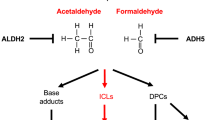Abstract
Lymphocytes from one normal male and one normal female were labeled with tritiated thymidine to study the autoradiographic patterns of association of acrocentrics, i.e., D and G groups. Association into groups of two and three acrocentrics was found to be random. These results are supported by a random association found in other cell lines studied without autoradiography. These include: normal persons, leukemic cell lines and several other instances where rearrangements of D and G chromosomes have been found.
Similar content being viewed by others
References
Brown D. D. & J. E. Gurdon (1964). Absence of ribosomal RNA synthesis in the anucleolate mutant ofXenopus laevis.Proc. Nat. Acad. Sci. U. S. 51: 139–146.
Cohen M. M. & M. W. Shaw (1967). The association of acrocentric chromosomes in 1000 normal human male metaphase cells.Ann. Hum. Genet. 31: 129–140.
De Capoa A., W. R. Breg, T. Kushnick & O. J. Miller (1968). Radioautographic identification of the D chromosomes involved in the centric fusion type of D/G translocation,t(DqGq).Ann. Hum. Genet. 32: 191–193.
Ferguson-Smith M. A. & S. D. Handmaker (1961). Observations on the satellited human chromosomes.Lancet i: 638–640.
Froland A. & M. Mikkelsen (1964). Studies on satellite associations in human cells.Hereditas 52: 248.
Galperin H. (1968). Comparative study on the association of human acrocentric chromosomes in male and female mitoses.Cytogenetics 7: 447–454.
German J. L. (1964). The pattern of DNA synthesis in the chromosomes of human blood cells.J. Cell Biol. 20: 37–55.
Harnden D. S. (1961). inRecent Advances in Human Genetics, L. S. Penrose, Ed. Boston, Massachusetts. Little, Brown, p. 32.
Hecht F., M. P. Case, E. W. Lovrien, J. V. Higging, H. C. Thuline & J. Melnyk (1968). Nonrandomness of translocations in man: preferential entry of chromosomes into 13–15/21 translocations.Science 161: 371–372.
Huberman J. A. & G. Attardi (1967). Studies of fractionated HeLa cell metaphase chromosomes I. The chromosomal distribution of DNA complementary to 28s and 18s ribosomal RNA and to cytoplasmic messenger RNA.J. Mol. Biol. 29: 487–505.
Nakagome Y. (1969). DNA replication studies of human D-group chromosomes in satellite associations.Cytogenetics 8: 296–303.
Ohno S., J. M. Trujillo, W. D. Kaplan & R. Kinosita (1961). Nucleolus organizers in the causation of chromosomal anomalies in man.Lancet II: 123–125.
Ritossa F. M. & S. Spiegelman (1965). Localization of DNA complementary to ribosomal RNA in the nucleolus organizer region ofDrosophila melanogaster.Proc. Nat. Acad. Sci. U.S. 53: 737–745.
Rosenkranz W. & S. Fleck (1969). Die bedeutung der assoziation satellitentragender chromosomen.Humangenetik 7: 9–21.
Sands V. E. (1969). Short arm enlargement in acrocentric chromosomes.Amer. J. Hum. Genet. 21: 293–304.
Schmid W. (1963). DNA replication patterns of human chromosomes.Cytogenetics 2: 175–193.
Shaw M. W., A. P. Craig & F. C. Ricciuti (1969). Random association of human acrocentric chromosomes.Amer. J. Hum. Genet. 21: 513–515.
Steele M. W. (1969). Autoradiography may be unreliable for identifying human chromosomes.Nature 221: 1114–1116.
Van Brink J. M., P. L. Los & A. J. Nienhaus (1962). Satellite associations and identification of the Y chromosome in man.Genetica 33: 45–51.
Yunis J. J., E. B. Hook & M. Mayer (1964). Deoxyribonucleic-acid replication pattern of trisomy D1.Lancet II. 935–937.
Zang K. D. & E. Back (1968). Quantitative studies on the arrangement of human metaphase chromosomes. I. Individual features in the association pattern of the acrocentric chromosomes of normal males and females.Cytogenetics 7: 455–470.
Author information
Authors and Affiliations
Additional information
This paper is dedicated with gratitude to my teacher Dr. MiguelJiménez S.
This study was supported by funds from the Universidad Nacional Autónoma de México and the Secretaria de Salubridad y Asistencia.
Rights and permissions
About this article
Cite this article
Cuevas-Sosa, A. Human chromosomology: Random association of acrocentrics. Genetica 41, 626–634 (1970). https://doi.org/10.1007/BF00958939
Received:
Issue Date:
DOI: https://doi.org/10.1007/BF00958939




